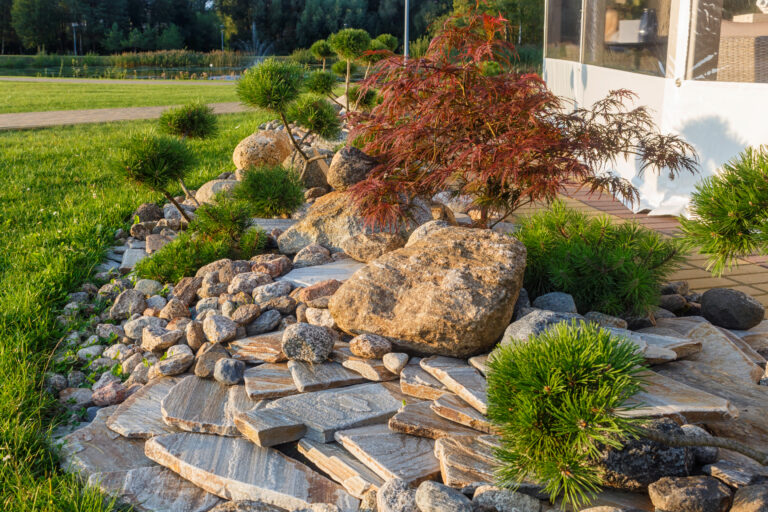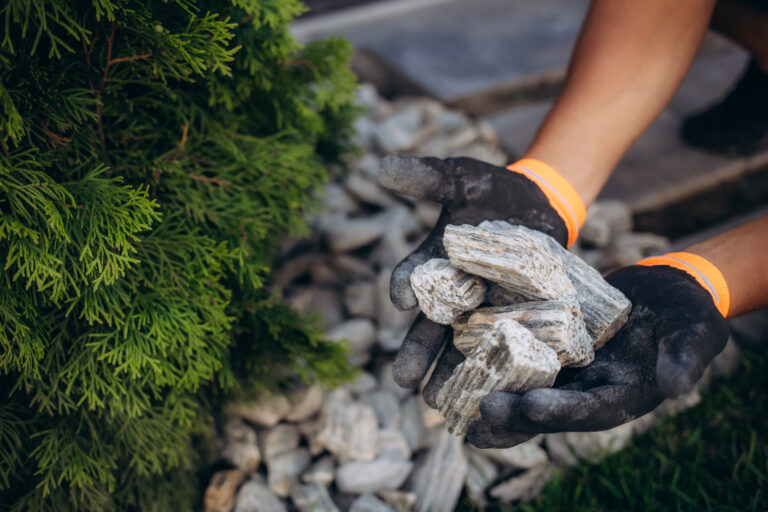Table of Contents
“Repurposing Landscape Rocks: 7 Cool Ways to Reuse Stones” explores creative and sustainable ways to integrate previously used landscape rocks into new and functional elements within your garden. This guide provides innovative ideas, ranging from constructing artistic rock features and cozy fire pits to practical uses like building retaining walls and edging garden beds. It highlights the dual benefits of enhancing the aesthetic appeal of your outdoor space while promoting environmental sustainability by reducing waste. Each suggestion is designed to help you utilize existing materials to transform and elevate your garden’s look and functionality, proving that old stones can find new life in various and unexpected ways in your landscaping projects.
Repurposing landscape rocks is a fantastic way to breathe new life into your garden design while being eco-friendly and resourceful. Here are seven cool ways to reuse stones in your landscape:
1) Create a Rock Garden
Creating a rock garden is a visually stunning and practical way to make use of landscape rocks, particularly in areas of your garden that are difficult to cultivate. This type of garden typically features a variety of rocks strategically arranged to simulate a natural, rugged mountainous terrain, complemented by alpine flowers, succulents, and other drought-resistant plants that thrive in well-drained soil conditions. The rocks not only serve as a dramatic backdrop, enhancing the visual appeal of the plants, but also help to regulate soil temperature and moisture levels. A rock garden can transform a barren or unused section of your yard into a beautiful and serene retreat, adding layers of texture and color while requiring minimal maintenance once established.
2) Build a Dry Creek Bed
Building a dry creek bed is not only a practical solution for managing landscape drainage but also a striking aesthetic addition to your garden. By strategically placing a variety of rocks and stones to mimic a natural stream, you can effectively channel water away from more vulnerable areas during heavy rains. The larger rocks are used to outline the edges, providing structure, while smaller stones fill the creek bed, simulating a natural riverbed. You can enhance its visual appeal by incorporating native plants, grasses, and mosses along the banks, which also help to stabilize the soil and integrate the creek bed seamlessly into the surrounding landscape. This feature serves the dual purpose of preventing erosion and creating a dynamic, naturalistic element in your garden, attracting wildlife and providing a tranquil focal point.

3) Construct a Retaining Wall
Constructing a retaining wall from repurposed landscape rocks is an effective and attractive way to manage sloped areas in your garden by preventing soil erosion and creating usable flat spaces for planting or other landscape activities. These walls can be built using various sizes of rocks, which not only provide necessary structural support but also add a rustic, natural aesthetic to the landscape. When building a retaining wall, it’s essential to ensure proper drainage behind the wall to prevent water pressure from building up and compromising the wall’s stability. The use of landscape fabric and a drainage pipe, covered with gravel, is commonly employed. This not only functionalizes steep areas but also transforms them into beautiful features, enhancing the overall design and utility of your outdoor space.
4) Design Pathways
Designing pathways using repurposed landscape rocks is a functional and decorative approach to enhancing the flow and beauty of your garden. By laying flat stones such as flagstones, slate, or river rocks, you create stable and aesthetically pleasing walkways that guide visitors through different sections of your outdoor space. These pathways can be bordered with smaller pebbles or plants that spill slightly over the edges, softening the lines between the pathway and the surrounding garden. This not only adds a charming, rustic element to the landscape but also helps reduce wear on the grass and prevents muddy tracks, ensuring your garden remains beautifully accessible regardless of the weather. Incorporating stone pathways is a practical way to add structure and order to your garden while maintaining its natural beauty and harmony.

5) Edge Your Garden Beds

Using landscape rocks to edge your garden beds is an effective way to delineate and enhance the structure of your garden. Stones of varying sizes can be strategically placed along the borders of garden beds to create a natural yet polished look that defines the edges, keeping soil and mulch neatly contained. This method of edging not only improves the visual appeal of the garden beds but also acts as a barrier to grass and invasive weeds, simplifying maintenance and protecting the plants within. Moreover, the stone edging can help prevent erosion and provide a clear path for mowing and trimming, minimizing accidental damage to plants. This practical and aesthetically pleasing solution can seamlessly integrate into any garden design, contributing to a clean and organized outdoor space.
6) Make a Fire Pit Area
Creating a fire pit area using repurposed landscape rocks can turn an ordinary backyard into a cozy gathering spot for friends and family. By arranging larger, heat-resistant stones in a circular pattern, you can build a sturdy and safe containment area for fires. The natural roughness of the stones adds a rustic charm to the fire pit, while the gaps between them ensure adequate air circulation to maintain a steady blaze. Surrounding the fire pit with gravel or sand can enhance safety and stability, preventing the spread of fire to nearby vegetation. Complementing this central feature with comfortable seating, such as stone benches or low walls, invites relaxation and extends the usability of your outdoor living space into the cooler evenings, making it a perfect spot for socializing and leisure.
7) Craft Artistic Features
Crafting artistic features with repurposed landscape rocks is a creative way to add a unique and personal touch to your garden. By arranging stones of different shapes, sizes, and colors, you can construct visually striking sculptures, rustic cairns, or intricate ground mosaics that serve as focal points in your outdoor space. These artistic creations not only showcase your personal style but also blend seamlessly with the natural landscape, enhancing its aesthetic appeal. Rock-based art can be functional as well, such as creating sundials, bird baths, or benches, which provide not just beauty but utility. Engaging in such projects encourages imagination and interaction with your garden, turning it into a canvas for artistic expression and a reflection of your artistic vision.

By expanding the use of landscape rocks in these ways, you not only make practical use of available materials but also enhance the beauty and functionality of your garden space. Each of these ideas can be tailored to fit the specific style and needs of your landscape, providing a personalized touch to your outdoor environment.
Additional Benefits and Tips
- Eco-Friendliness: Repurposing rocks reduces the need for new materials and minimizes waste, making your garden more sustainable.
- Cost-Effectiveness: Using materials you already have saves money on landscaping projects.
- Natural Fit: Rocks blend naturally with the landscape, enhancing the garden’s organic feel.
Conclusion
In conclusion, repurposing landscape rocks offers a blend of aesthetic enhancement, practical utility, and environmental sustainability for your garden. Whether you’re building a serene rock garden, crafting a functional dry creek bed, or adding artistic elements like rock sculptures, these stones can transform your outdoor space into a more engaging and enjoyable area. By creatively reusing landscape rocks, you not only beautify your garden but also contribute to a greener planet. These versatile materials prove that with a little imagination, the possibilities in garden design are as vast as they are rewarding. For more detailed information and tailored advice, visit our page on rock removal. For support on your next rock removal project, please feel free to reach out through our contact form, and our team will be happy to help.



